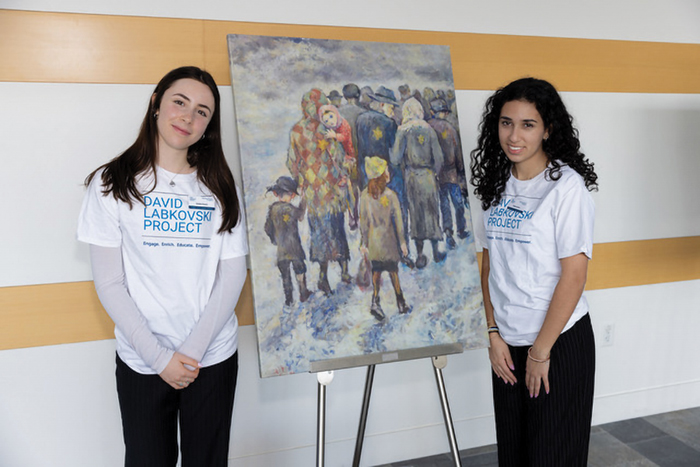Danielle Berrin shows off the rainbow
Longtime collaborators architect Moshe Safdie and artist Ned Kahn were busy designing the new headquarters for the Bureau of Alcohol, Tobacco and Firearms in Washington D.C. when Safdie invited Kahn to “think about rainbows.” Standing in a courtyard, staring into a design he describes as a reflecting pool, Kahn’s first thoughts were of water. Then came the flood — ice melting, rising sea levels, global warming; then artwork bridging man and nature; and the image of someone standing on a cliff becoming engulfed by a wave.
All he had to do was figure out how to break water into the perfect-sized droplets to create a rainbow. And then he did.
Just beyond the new Noah’s Ark installation at the Skirball Cultural Center, where Asian elephants and Boringo giraffes tower, a lushly landscaped courtyard has been designed as a rainbow arbor.
Rising from a base of rocks, Kahn’s rainbow is a curved metal form that wraps around a walkway, spraying droplets of mist that coalesce to form a rainbow. It is the marriage of a museum exhibit and a symbolic natural oasis, recalling both the benevolent and destructive elements of nature and symbolizing God’s promise to Noah not to flood the earth again.
To prepare for the arbor’s construction, Kahn studied many versions of the Noah story: “I remember being struck by how many different cultures had references to a flood, the way flood stories seem like part of the collective memory of humankind.”
Having studied environmental science, Kahn often blends natural and man-made elements to create contemplative sanctuaries that connect people to the forces of nature.
“I think you could say that most of my work is located in urban environments, where people are disconnected from natural forces and phenomena, so a lot of what I’ve created is part of this realization that everything is a man-nature hybrid.”
The rainbow arbor relies on the unpredictability of each day’s elements: “I stuck a bunch of pieces of metal together, put novels [apparatuses that break the water] into it and ran water. But when you turn it on, it’s the wind and sunlight that animates it … it’s not entirely my creation.”
The central image came to him in a dream: “I was with my father, and we were on a hillside watching a wave crash, and it was really gentle, and when it hit us, we were washed away by it. But it was this sweet, nice dream … probably the opposite of what most people think of floods.”
Indeed, the sculpture’s abstract shape resembles an undulating wave, but as in Kahn’s dream, it is a delicate form — with perforated metal that appears transparent and a mist that sprinkles your skin, the way it would if you were behind a waterfall.
Conceived as a climax to the whimsical and wild experience of the Noah’s Ark exhibit, the rainbow arbor provides a contrast in its soothing, sensory experience.
In a world where man is increasingly alienated from untainted nature and global warming threatens the planet, Kahn’s mist sculpture embodies the hope of a promising future — or, as he puts it: “The rainbow was the symbol that they had made it.”
The rainbow can be found at the Skirball Cultural Center, 2701 N. Sepulveda Blvd., Los Angeles. (310) 440-4500. Skirball hours: Tues.-Fri., noon-5p.m; Thurs., noon-9 p.m.; Sat., Sun., 10 a.m.-5 p.m. For more information, visit http://www.skirballcenter.org























 More news and opinions than at a Shabbat dinner, right in your inbox.
More news and opinions than at a Shabbat dinner, right in your inbox.